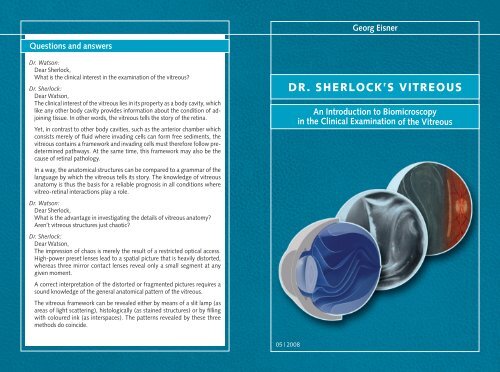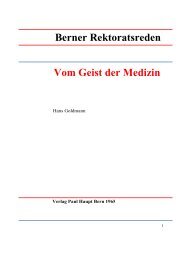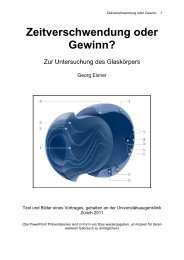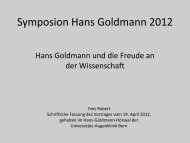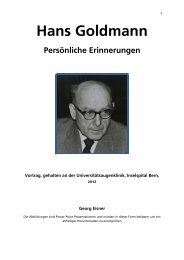Booklet - Georg Eisner, Ophthalmologie
Booklet - Georg Eisner, Ophthalmologie
Booklet - Georg Eisner, Ophthalmologie
Create successful ePaper yourself
Turn your PDF publications into a flip-book with our unique Google optimized e-Paper software.
<strong>Georg</strong> <strong>Eisner</strong><br />
Questions and answers<br />
Dr. Watson:<br />
Dear Sherlock,<br />
What is the clinical interest in the examination of the vitreous<br />
Dr. Sherlock:<br />
Dear Watson,<br />
The clinical interest of the vitreous lies in its property as a body cavity, which<br />
like any other body cavity provides information about the condition of adjoining<br />
tissue. In other words, the vitreous tells the story of the retina.<br />
Yet, in contrast to other body cavities, such as the anterior chamber which<br />
consists merely of fluid where invading cells can form free sediments, the<br />
vitreous contains a framework and invading cells must therefore follow predetermined<br />
pathways. At the same time, this framework may also be the<br />
cause of retinal pathology.<br />
In a way, the anatomical structures can be compared to a grammar of the<br />
language by which the vitreous tells its story. The knowledge of vitreous<br />
anatomy is thus the basis for a reliable prognosis in all conditions where<br />
vitreo-retinal interactions play a role.<br />
Dr. Watson:<br />
Dear Sherlock,<br />
What is the advantage in investigating the details of vitreous anatomy<br />
Aren’t vitreous structures just chaotic<br />
Dr. Sherlock:<br />
Dear Watson,<br />
The impression of chaos is merely the result of a restricted optical access.<br />
High-power preset lenses lead to a spatial picture that is heavily distorted,<br />
whereas three mirror contact lenses reveal only a small segment at any<br />
given moment.<br />
A correct interpretation of the distorted or fragmented pictures requires a<br />
sound knowledge of the general anatomical pattern of the vitreous.<br />
The vitreous framework can be revealed either by means of a slit lamp (as<br />
areas of light scattering), histologically (as stained structures) or by filling<br />
with coloured ink (as interspaces). The patterns revealed by these three<br />
methods do coincide.<br />
Dr. Sherlock’s Vitreous<br />
An Introduction to Biomicroscopy<br />
in the Clinical Examination of the Vitreous<br />
05 | 2008
Biography of <strong>Georg</strong> <strong>Eisner</strong><br />
<strong>Georg</strong> <strong>Eisner</strong> was born 1930 in Basel, Switzerland, to<br />
Willy <strong>Eisner</strong>, M.D. (Internal Medicine) and Irma <strong>Eisner</strong>-<br />
Guggenheim, M.D. (Ophthalmology). He is married to<br />
Susanne <strong>Eisner</strong>-Kartagener, has three children, Daniel,<br />
Miriam, Simone, and six grandchildren, Yael, Ruben,<br />
Nomi, Manuel, Marva and Miron.<br />
As a young man,<br />
<strong>Georg</strong> <strong>Eisner</strong> attended a humanities-oriented high school, the “Humanistisches<br />
Gymnasium” in Basel. He then worked as a carpenter in a kibbutz before attending<br />
medical school at the Universities of Basel and Paris. He received his<br />
M.D. degree in 1960.<br />
Later in life,<br />
<strong>Georg</strong> <strong>Eisner</strong> was being trained in ophthalmology with both Prof. F. Rintelen in<br />
Basel and with Prof. H. Goldmann and Prof. P. Niesel in Bern. As a full professor<br />
of ophthalmology, he held leading positions at the Bern University Eye Hospital<br />
(Inselspital), and as Dean of the Faculty of Medicine. In 1989, the medical students<br />
awarded Prof. <strong>Eisner</strong> the diploma “Teacher of the Year“. He retired from<br />
his academic positions in 1993.<br />
Prof. <strong>Eisner</strong>’s research interests are well illustrated by his principal publications:<br />
• Biomicroscopy of the Peripheral Fundus (Springer Verlag 1973)<br />
• Clinical Anatomy of the Vitreous (in Duane’s Biomedical Foundations in Ophthalmology,<br />
J.B.Lippincott 1989)<br />
• Introduction to the Biomicroscopy of the Eye (DVD-series, Haag-Streit, 2002)<br />
• Eye Surgery (Springer Verlag 1978/80, 1990)<br />
• Various scientific reports in the field of viscosurgery<br />
Since his retirement, Prof. <strong>Eisner</strong> has been enjoying family life, leisure, nature<br />
and art. He is the author of several introductions to contemporary art catalogues,<br />
as well as of many lectures and publications in a number of subjects<br />
such as:<br />
• physiological optics and art<br />
• color deficiency and painting<br />
• aniconism and the prohibition of pictorial presentation<br />
• migration of symbols<br />
• the art of gold casting in West Africa<br />
Acknowledgements<br />
This program is offered to the ophthalmic community gratuitously through<br />
the support of the following sponsors<br />
• Ambulante Augenchirurgie Zürich<br />
• Alcon Switzerland SA<br />
• Werner H. Spross-Stiftung Zürich<br />
• Swiss Ophthalmological Society SOG/SSO<br />
and by the author<br />
Special thanks<br />
This program would not have been possible without the help of<br />
• Prof. Elmar Messmer, Zürich, CH<br />
• Prof. Yves Robert, Zürich, CH<br />
• Prof. Jan Worst, Groningen, NL<br />
• Prof. Sebastian Wolf and collaborators, University Eye Clinic,Inselspital,<br />
Bern, CH<br />
• Birgit Stuber, Alcon Pharmaceuticals Ltd., Switzerland<br />
• Willy R. Hess, Adelheid Meyer, scientific illustrators<br />
• Dr. Peter Frey, Hans Holzherr, Giovanni Ferrieri, Béatrice Boog<br />
(Education and Media Unit, University of Bern)<br />
• Dr. Christoph Amstutz, Zürich, CH<br />
• Susanne <strong>Eisner</strong>-Kartagener, Bolligen, CH<br />
• The patients of the University Eye Hospital, Bern, who voluntarily agreed to<br />
undergo the cumbersome examination with the video slit lamp for the sole<br />
purpose of assisting in the training of future ophthalmologists<br />
Production<br />
• Education and Media Unit, Institute of Medical Education,<br />
University of Bern<br />
• Producer: Dr. Peter Frey, M.D<br />
• Graphical work: Hans Holzherr<br />
• Technical assistance: Giovanni Ferrieri<br />
• Layout of the printouts: Béatrice Boog
Illustrations in high resolution<br />
In addition to DVD-videos, the discs contain scientific illustrations in high<br />
resolution for printing or embedding in PowerPoint presentations.<br />
The additional material is accessible only when using the DVD as a normal<br />
data disc on a personal computer (PC or Macintosh).<br />
Artwork<br />
The use of artistic drawings as well as video-sequences combines the advantages<br />
of both imaging techniques: the continually moving scenery during slit<br />
lamp examination which the examiners must stabilize in their minds, and the<br />
comprehensive view of the artist.<br />
In addition, for posterity’s sake, we have saved a form of art doomed for<br />
oblivion: pictures drawn after nature by artists especially trained in biomicroscopic<br />
examination techniques. One series was drawn by Adelheid Meyer for<br />
the Goldmann collection that was part of the Swiss contribution to science<br />
at the World Exhibition in Bruxelles in 1958 (partially published in the “Rapport<br />
de la société française d’ophtalmologie 1958”, now at the University Eye<br />
Hospital, Inselspital, Bern). The other set was drawn by Willi Hess for various<br />
publications authored by <strong>Georg</strong> <strong>Eisner</strong> (now at the Institute for the History<br />
of Medicine, Bern). The graphical work was drawn by Hans Holzherr (with<br />
some parts especially designed for this program, while others made for<br />
the DVD program: <strong>Georg</strong> <strong>Eisner</strong>, Introduction to Biomicroscopy of the Eye,<br />
Haag-Streit AG, 2002).<br />
Copyright<br />
© Schweizerische Ophthalmologische Gesellschaft /<br />
Société suisse d’ophtalmologie / Società svizzera di oftalmologia<br />
Copying is permitted under the condition that no changes are made in any<br />
parts of the program and its presentation.<br />
Using parts of this program is permitted with acknowledgment of<br />
the source: “<strong>Eisner</strong> <strong>Georg</strong>: Dr. Sherlock’s Vitreous; DVD Supplement<br />
to the Goldmann-Lecture 2008 (© Schweizerische Ophthalmologische<br />
Gesellschaft, 9435 Heerbrugg, Hrsg.)”<br />
About this program<br />
“By <strong>Georg</strong>e!” cried the inspector. “How ever did you see that”<br />
“Because I looked for it.”<br />
(From Sherlock Holmes “The Adventure of the Dancing Men”)<br />
Sherlock Holmes (whose creator, Sir Arthur Conan Doyle, happened to be<br />
a trained ophthalmologist) has always been one of my favourite heroes. His<br />
example guided me whenever I taught students the art of observing minute<br />
signs that can be easily overlooked, the kind of signs that Sherlock would have<br />
pointed out to his rivals at Scotland Yard with a fine twinkle in his eye.<br />
I myself was taught this art by Hans Goldmann, my venerable teacher, who<br />
would insist on our looking out for discreet, concealed, and unexpected signs<br />
indicative of a correct diagnosis. The vitreous is indeed a treasure trove for<br />
such signs.<br />
In this program, Dr. Sherlock is a lady, in honor of my mother, Dr. Irma <strong>Eisner</strong>-<br />
Guggenheim, who was among the first women ophthalmologists in Switzerland.<br />
I also like to pay tribute to my teachers Hans Goldmann, Peter Niesel,<br />
and Franz Fankhauser, who taught me not only the art of ophthalmology as<br />
such, but also the pleasure of further promoting it. Passing on this heritage to<br />
future generations has been our main goal.<br />
“Introduction to Biomicroscopy in the Clinical Examination of the Vitreous”<br />
contributes to this goal in two ways. On the one hand, it contains a textbook<br />
offering a systematic approach to the anatomy and the pathology of the vitreous.<br />
On the other hand, it also includes a compilation of video-sessions of<br />
selected cases with Dr. Sherlock explaining vitreous signs indicative of posterior<br />
segment pathology. Links are provided to switch from one section to the<br />
other and thus to correlate actual cases with their theoretical background.<br />
<strong>Georg</strong> <strong>Eisner</strong><br />
Terminology<br />
Terminology in the field of the vitreous is often misleading because historical<br />
factors and local preferences have led to the use of identical terms for different<br />
anatomical structures. To avoid confusion, only descriptive terms are used<br />
in this program. The aim is not to replace established local usage, but merely<br />
to simplify the access to this program for users with different backgrounds.
Content Disc 1<br />
The Normal Anatomy of the Vitreous<br />
Schematic Description<br />
Slit Lamp Examination of Autopsy Specimens<br />
Development and Ageing<br />
Slit Lamp Examination of Living Eyes<br />
Content Disc 2<br />
PATHOLOGY OF THE VITREOUS<br />
Posterior Vitreous Detachments<br />
Invasion of the Vitreous Cavity by Foreign Substances<br />
Semiology of the Posterior Limiting Lamina (PLL)<br />
• Deformations of the PLL (“Omega-Folds”)<br />
• The Syndrome of the Pseudo-PLL<br />
• The Thick PLL<br />
• Deposits on the Posterior Limiting Lamina<br />
Semiology of the Vitreous Base<br />
• Tears at the Vitreous Base<br />
• Classification of Retinal Defects<br />
• Disruptive and Non-Disruptive Lesions<br />
• Inflammation at the Vitreous Base<br />
ADDITIONAL INFORMATION<br />
Optical and Structural Properties<br />
• Light Scattering and Mechanical Properties<br />
• Light scattering and Anatomical Properties<br />
• Transparency and Structural Properties<br />
The Origin of Vitreous Tracts and the Preretinal Lacunae<br />
Slitlamp Photography in Autopsy Eyes<br />
Technique of Examination<br />
FROM THE CASEBOOK OF DR. SHERLOK<br />
Tales of Vitreous Tracts, Laminae and Lines<br />
• Finding Ariadne’s Threads in the Cavity of the Vitreous<br />
• What is Wrong with Tracts Running the Wrong Way<br />
• One Lamina Too Many<br />
• Omega-Folds as Alpha-Signs of Imminent Danger<br />
• The Enigma of Horizontal Lines<br />
Stories of Vitreous Detachments and the Vitreous Base<br />
• Lessons from the Shape of the Emptying Bag<br />
• Atypical Patterns of Vitreous Detachments after a Punch<br />
• How Do Ora Tears Differ from all the other Tears<br />
• The Case of Straight Lines, No Folds, a Flap Tear, and No Retinal<br />
Detachment<br />
Stories of Invading Substances<br />
• What Sediments Tell about their Sites of Origin<br />
• A Case of Progression, Regression, and Recurrence of Inflammation<br />
• How Unusual Patterns of Hemorrhages Lead to Unusual Sources


